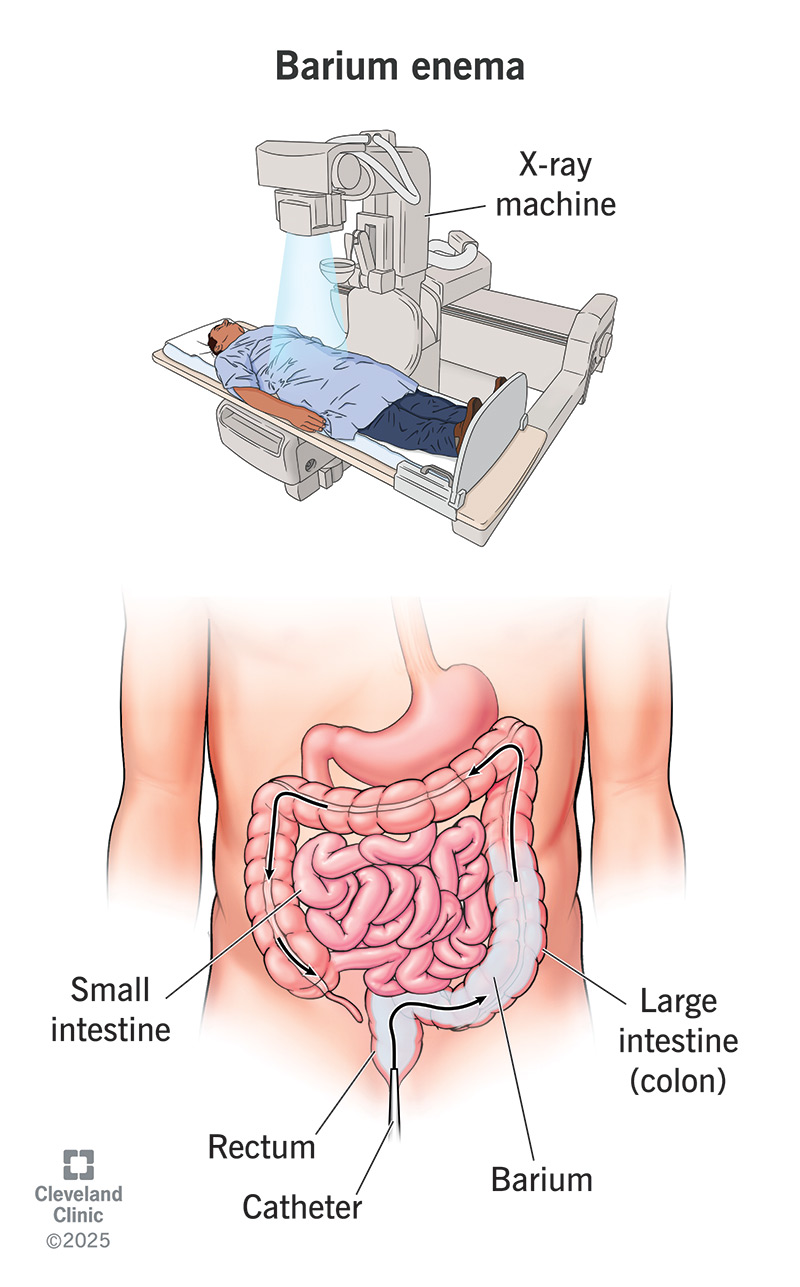A barium enema (contrast enema or lower GI series) is a special type of X-ray for your large intestine. It involves filling your bowel with a contrast substance called barium, which makes the X-rays show up better. A healthcare provider inserts the barium into your rectum like an enema before taking pictures.
Advertisement
Cleveland Clinic is a non-profit academic medical center. Advertising on our site helps support our mission. We do not endorse non-Cleveland Clinic products or services. Policy

A barium enema is a gastrointestinal exam that takes X-rays inside your large intestine (colon). Before taking the X-rays, a healthcare provider inserts a special fluid into your rectum (this is called an enema). The fluid, called barium, is a chalky white substance that coats the inside of your intestine. This makes the images clearer. Barium is a type of contrast fluid. A barium enema is also called a contrast enema.
Advertisement
Cleveland Clinic is a non-profit academic medical center. Advertising on our site helps support our mission. We do not endorse non-Cleveland Clinic products or services. Policy
There are two types:
You might have a barium enema if you have unexplained symptoms affecting your large bowel, like:
The test can reveal things in your intestine that might help explain your symptoms, like:
A barium enema (or “lower GI series”) is just one of several tests that examine your lower GI tract. Different types of exams have different pros and cons for different people. Barium enemas aren’t as common as they used to be because other tests like colonoscopy and colonography work better, in many cases. But in others, a barium enema may have certain benefits over these tests.
For example:
Advertisement
X-rays (radiography) use small doses of radiation to create images of your internal organs and body tissues. A barium enema uses a special type of X-ray called fluoroscopy, which is like a video X-ray. It shows real-time movement in your organs, which can be helpful for observing how they’re working. Contrast fluids like barium make things easier to see inside. You can also watch the fluid move through your colon.
For the test to work, your bowel will need to be clear. Your provider will prescribe a bowel preparation to complete before the test, similar to what you would do before a colonoscopy. Most bowel prep kits come with an oral laxative and detailed instructions on how to take it. In most cases, you’ll follow a clear liquid diet for a few days before taking the laxative. Some people may receive different instructions.
Tell your provider about any current medications, supplements and health conditions, including pregnancy. They might reschedule your test or adjust your instructions, depending on your conditions.
A radiologist or radiology technician will perform your exam in a hospital or outpatient radiology center. A barium enema usually takes about 30 to 60 minutes. When you arrive for the procedure, you’ll change into a hospital gown. Then, you’ll lie on the exam table on your side. You won’t have sedation or anesthesia, so you’ll be fully aware and able to converse with your technicians during the test.
Your provider will:
As the fluid (and gas) fills your bowel, you may feel uncomfortably full or like you have to poop. (Don’t worry, you won’t. The balloon on the end of the tube will catch any leakage.)
Constipation is the most common side effect of a barium enema. Drinking lots of water after the procedure can help prevent this. Most cases are mild, but if it’s severe, it could obstruct your bowel.
Some bowel preps can rarely cause electrolyte imbalances or kidney injury in some people, due to the sodium phosphate in the formula. Your healthcare provider will choose an appropriate formula for you.
Other risks and complications are very rare. They include:
Advertisement
After the test, you can go back to your normal eating habits and activities. You may feel some bloating or discomfort for the next hour or so. It should improve as the barium and gas leave your system. Your poop may look a little white from the barium for the next few days. If you feel like you can’t poop or pass gas, call your provider. They’ll offer ways to help get things moving and intervene if necessary.
It may be several days before you hear the results of the test. Your healthcare provider will contact you after receiving the report from your radiologist. They’ll discuss the results and what they suggest next.
Be sure to call your provider if you develop any concerning symptoms after the procedure, like:
A barium enema is one of several tests your provider might suggest to find out what’s causing your GI symptoms. Tests that look at your GI tract can be uncomfortable or embarrassing in different ways, but healthcare providers work to minimize this. Most people find they’re not as bad as they feared. Besides, it’s worth it to find out what’s going on in there. Once you do, you can turn your attention to treating it.
Advertisement
If you have issues with your digestive system, you need a team of experts you can trust. Our gastroenterology specialists at Cleveland Clinic can help.

Last reviewed on 06/09/2025.
Learn more about the Health Library and our editorial process.